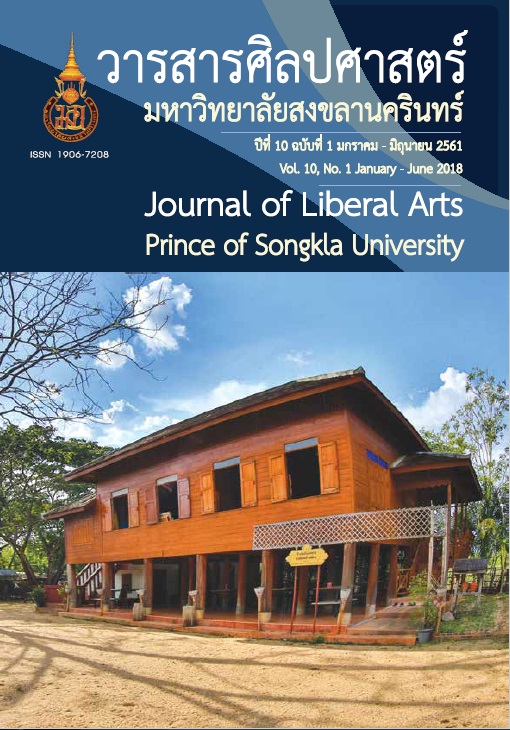Intercultural communicative competence components: An analytical study of English-for-tourism curricula of universities in Southern Thailand
Keywords:
Intercultural communicative competence (ICC), tourism, curriculumAbstract
This article is an analytical study of intercultural communicative competence (ICC) in English for tourism curricula at 5 universities in Southern Thailand to find out whether ICC components exist in the present curricula. Content analysis based on Byram’s (1997) components of an ICC curriculum was employed. The study reported the status quo of the target English for tourism curricula and proposed the implications for ICC curriculum establishment.
References
Assanova, G. S., & Kim, C. H. (2014). Formation of students’ intercultural communicative competence in business communication. Middle East Journal of Scientific Research, 19(5), 642-646.
Bennett, M. J. (2011, February 20-23). Developing intercultural competence for international education faculty and staff. Leaders in international higher education 2011 AIEA conference workshop. Organized by Association of International Education Administrators.
Byram, M. (1997). Teaching and assessing intercultural communicative competence. Clevedon, England: Multilingual Matters LTD. Byram, M., Gribkova, B., & Starkey, H. (2002). Developing the intercultural dimension in language teaching. Strasbourg: Council of Europe.
Chlopek, Z. (2008). The intercultural approach to EFL teaching and learning. English Teaching Forum. 4, 10-27.
Clandfield, L. (2008). Culture in ELT: Which C? Whose C?. Teaching of English as a second language of Ontario, 34(3), 4-8.
Deardorff, D. K. (2008). Intercultural competence: A definition, model, and implications for study abroad. In V. Savicki (Ed.), Developing intercultural competence and transformation: Theory, research, and application in international education. Sterling, VA: Stylus.
Elo, S., & Kyngas, H. (2007). The qualitative content analysis process. JAN: Research Methodology. Blackwell Publishing Ltd.
Fantini, A. E. (2005). About intercultural communicative competence: A construct. School for international training. Brattleboro, Vermont, USA.
Gannon, J. (2008). Developing intercultural skills for international industries: The role of industry and educators. Hospitality, leisure, sport and tourism network: Enhancing Series: Internationalization. November, 1-14.
Gerritsen, M., & Verckens. J. P. (2006). Raising students’ intercultural awareness and preparing them for intercultural business (Communication) by E-mail. Business Communication Quarterly. 69(1), 50-59.
Gertsen, M. C. (1990). Intercultural competence and expatriates. Intercultural Journal of Human Resources Management. 11(3), 341-362.
Gitimu, G.N. (2010). Intercultural communication: Its importance to various career fields and perspective by various authors. (Doctoral dissertation). Southern Illinois University Carbondale.
Ho, S. (2009). Addressing culture in EFL classrooms: The challenge of shifting from a traditional to an intercultural stance. Electronic Journal of Foreign Language Teaching. 6(1), 63-76.
Hofstede (2001, as cited in Johnson, J. P., & Lenartowicz, T., and Apud,S.). (2006). Cross-cultural competence in international business: Toward a definition and a model. Journal of International Business Studies. 37, 525-543.
Juan, E. U., & Flor, A. M. (2008). Teaching intercultural communicative competence through the four skills. Revista Alicantina Estudios Ingleses. 21, 157-170.
Kachru, B. B. (1985) Standards, codification and sociolinguistic realism: The English language in the outer circle. In R. Quirk and H. G. Widdowson (Eds.). English in the world: Teaching and learning the language and literatures (pp.11-30). Cambridge: Cambridge University Press.
Kaewpet, C. (2009). A Framework for investigating learner needs: Needs analysis extended to curriculum development. Electronic Journal of Foreign Language Teaching. 6(2), 209-220.
Knutson, T. J., Komolsevin, R., Chatiketu, P., & Smith, V. R. (2003). A cross cultural comparison of Thai and US American rhetorical sensitivity: Implications for intercultural communication effectiveness. International Journal of Intercultural Relations, 27, 63-78.
Komolsevin, R., Knutson, T. J., & Datthuyawat, P. (2010). Effective intercultural communication research contributions from Thailand. Journal of Asian Pacific Communication. 20(10), 90-100.
Kongkerd, W. (2013). Teaching English in the era of English used as a lingua franca in Thailand. Executive Journal. 33(4), 3-12.
Kriauciūniene, R., & Šiugždiniene, A. (2010). Viewpoints of intercultural competence development in English language teaching/ learning classroom. KALBU DIDAKTIKA. 2, 95-100.
Krieger, D. (2005). Teaching ESL versus EFL: Principles and practices. English Teaching Forum. 43(2), 83-92.
Liu, L., & Zhang, Y. (2014). The application of constructivism to the teaching of intercultural communication. English Language Teaching. 7(5), 136-141.
McDaniel, E. R., Samovar, L. A., & Porter, R. E. (2007). Communication between culture (8thed.). USA: Wadworth.
Mitchell, P., Pardinho, L. A., Aguiar, N. Y., & Meshkov, L. V. (2015). Language learning and intercultural communicative competence: An action research case study of learners of Portuguese. Procedia-Social and Behavioral Sciences. 200(2015), 307-312.
Modiano, M. (2009). EIL, Native-speakerism and the failure of European ELT. In Sharifian, F. (Ed.), English as an international language: Perspectives and pedagogical issues. Great Britain: MPG Books Ltd.
Mora, M. A. C. (2015). Attitudes towards intercultural communicative competence of English for specific purposes students. Procedia-Social and Behavioral Sciences. 178(2015), 26-31.
Neuliep, J. (2011). The nonverbal code in Intercultural communication: A contextual approach (pp. 285-332). Thousand Oaks, CA: Sage Publications.
Popescu, T., & Iordachescu, G. D. (2015). Raising students’ intercultural competence through the process of language learning. Procedia-Social and Behavioral Sciences. 197(2015), 2315-2319.
Pratoomrat, P., & Rajprasit, K. (2014). Providing business English introduction: Thai instructors’ practices and students’ perceptions. English Language Teaching. 7(9), 144-155.
Reid, E. (2015). Techniques developing intercultural communicative competences in English language lessons. Procedia-Social and Behavioral Sciences. 186(2015), 939-943.
Sangpikul, A. (2009). Internationalization of hospitality and tourism education: A Perspective from Thailand. Journal of Teaching in Travel and Tourism. 9(1), 2-10.
Sanonguthai, S. (2014). Ready or not? The state of Thai schools in response to. 16(2), 128-142.
Sercu, L. (2002). Autonomous learning and the acquisition of intercultural communicative competence: Some applications for course development. Language, Culture and Curriculum. 15(1), 61-74.
Wisansing, J. (2005). The internationalization of tourism and hospitality education in Thailand, paper presented at the Inter-University Conference, ASAIHL, 18 July N2005, Thailand.
Downloads
Published
How to Cite
Issue
Section
License
The authors retain the copyright to their article but the Journal of Liberal Arts, Prince of Songkla University reserves the exclusive rights to first publication.






